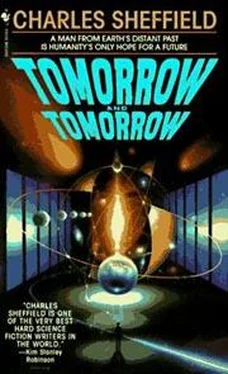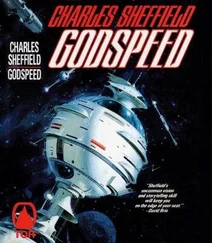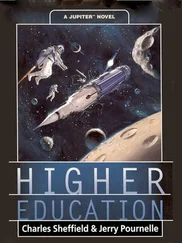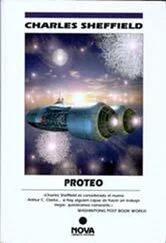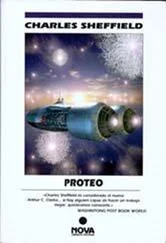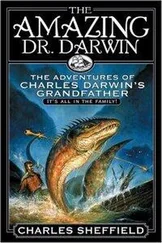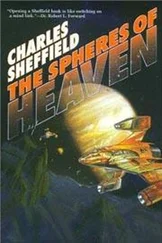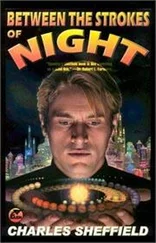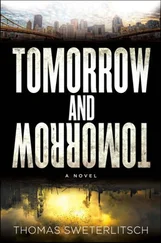He angled wide of another group of ships that had appeared far ahead. They moved toward him, but he was racing along too fast. He was soon past them. Still at maximum acceleration, he fled for the edge of the solar system.
As soon as the sky was clear ahead, he set a course for Canopus.
At last he was able to breathe. If he might have been judged a murderer in an earlier generation for what he and Tom Lambert had done to Ana, he was certainly considered a thief or worse in this one.
Who cared? He and Ana were together, that was all that mattered. Although pursuit was still possible, he could see no signs of it. And he would be hard to catch. The ship was still accelerating monstrously. Soon it would crowd light speed, moving just 125 meters per second slower than a traveling wave front. Even that was not the limit. If need be, he could reach within a meter a second of light speed.
But it should not be necessary. He examined the control board. Unless he saw signs of pursuit, their planned top speed would be just right. Relativistic time dilatation was going to be a powerful factor. Years would pass on Earth for every day of shipboard time. The trip out to Canopus and back would be a few months for him, but almost three hundred years back on Earth.
And for Ana?
She was still trapped outside of time, in her personal fermata, a temporal hiatus without end where duration and interval did not exist.
He felt a great urge to gaze upon her face within the sealed cryotank. Instead he moved forward to peer ahead to the distant star that he had chosen as their destination. Even from a hundred light-years away, by some miracle of the ship’s imaging system Canopus was already revealed as a tiny bright disk.
He went to where the ship’s computer was housed. Now that they were far beyond pursuit, he had returned to automatic control. He was curious to see what the computer looked like, the multipurpose processor that with equal ease planned trajectories, cooked meals, and maintained all the onboard life-support systems.
He lifted the plastic access panel to the main processor, and peered into a small dark cavity. He saw a lattice of red beads, each one no bigger than a pinhead. Tiny sparkles of violet light passed among them. A soft voice from the ship’s address system said in mild rebuke, “ Exposure to external light sources is discouraged, since it causes the computer to operate with reduced speed and efficiency.”
Drake went back to the controls and turned his attention to the general functions of the ship. It could support him and his life-system needs, apparently indefinitely. Its speed and maneuverability never ceased to amaze him. And yet it was in many ways less surprising than the civilization that had made it. A civilization that could produce such a miracle of performance and potential — and then allow it to go unused; that was the most incomprehensible mystery of all.
Was it the temporal dislocation produced by time dilatation that was psychologically unacceptable to humans? Drake was depending on it. But did others hate to leave, and upon their return find their friends in the cryowombs, or perhaps dead? But as lifespans increased, that would be less and less a factor. If that were the main reason why the ships were not more widely used, the future should see more travel to the stars.
The ship was approaching its planned maximum speed. Drake noticed that the ship’s external mass indicator showed more than 140,000 tons, up from a rest mass of 130 tons. To an outside observer, Drake himself would seem to mass eighty-eight tons, and be foreshortened to a length of less than two millimeters. The shields hid the view ahead of the
ship, but he knew that the picture he was seeing on his screen had been subjected to extreme image motion compensation. An unshielded view would reveal the universal three-degree background radiation, Doppler-shifted up to visible wavelengths. Far behind, hard X-ray sources were faded to pale red stars.
The ship was nowhere close to its performance limits. If necessary, he and Ana could fly on forever, to the end of the universe. Except that he was confident that it would not be necessary. He closed his eyes and heard a broad, calm melody, the music of the stars themselves, stirring within his brain. He lay back and allowed music to fill his mind.
For the first time in five centuries, Drake was at peace.
“Yet each man kills the thing he loves”
In the silence between the stars there were no distractions. Drake started to compose again, convinced that it would be his best work ever. It would distill all his emotions, for all the days since that ominous first morning when he had seen a red car in the drive where no car should have been; on through the darkest days, when nothing seemed possible; on all the way to the glad confident morning of the present.
The ship’s flight was fully controlled by its tiny but vastly capable computer. In her cabin aft, Ana lay safe in the cryotank. Drake had all the time that he needed. As the days went by, he allowed the new composition to mature steadily within him. If ever he felt like a break, he would go to Ana’s room, sit down by the cryotank, and reveal to her his thoughts and dreams.
He assured her that a few months of shipboard time would be enough. Almost three hundred years would speed away on Earth, before their return, and in those centuries Earth’s physicians would surely have found a safe and certain cure. If they had not, he would simply head out again, and repeat the entire cycle.
And what if, after many tries, Earth finally fails us?
He imagined Ana’s question in his mind, and he had an answer. They would go elsewhere, on beyond the stars in search of other solutions. The ship was completely self-sustaining. It had ample power and supplies for many subjective lifetimes of travel.
But Drake hoped that one trip would be enough. He told Ana that it was one of his smaller ambitions, on his return, to locate the cryocorpse of his friend Par Leon and return the favor. She would like Par Leon.
He was strangely, sublimely happy, as the ship approached Canopus. His original plan had been for a gravitational swing-by, a maneuver that would take the ship through a tight hyperbolic trajectory close to Canopus and then hurtle away again the way they had come.
But perhaps he had been enjoying himself too much to be in a hurry, or maybe he felt a simple curiosity to see what worlds might circle another sun. For whatever reason, he chose to decelerate during the last couple of weeks and put the ship into a bound orbit about four hundred million kilometers from Canopus.
He turned the ship’s imaging devices to scan the stellar system. There were planets, as he had hoped, four gas-giants each the size of Jupiter. Closer in he located a round dozen of smaller worlds. But he had ignored or forgotten the infernal power of Canopus itself. It was a fearsome sight, more than a thousand times as luminous as the Sun and spouting green flares of gas millions of kilometers long. The inner planets were mere blackened cinders, airless and arid, charred by the furnace heat of the star. The outer gas-giants were all atmosphere, except for a small compressed solid core where the pressure was millions of Earth atmospheres. No life in any form that he would recognize could exist there.
But he stayed and looked. In two days of fascinated observation, his eyes turned again and again to the fusion fire of Canopus. He wondered. Had some other human been here, when ships like the one that he was flying were new? Had any intelligence been here before, human or nonhuman? Or were his the first sentient eyes to dwell on those dark twisted striations — not sun-spots, but sun scars — that gouged the boiling surface of the star?
Читать дальше
